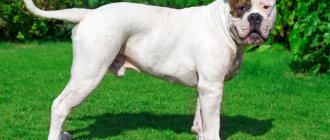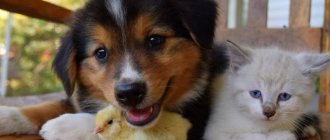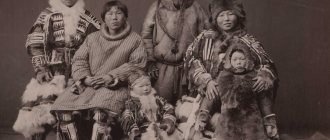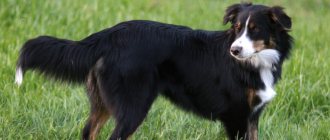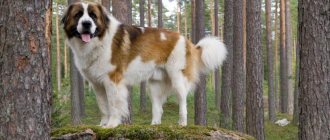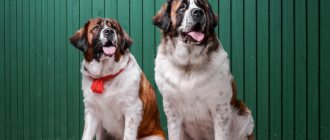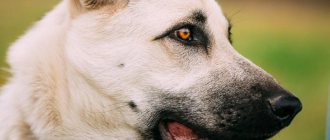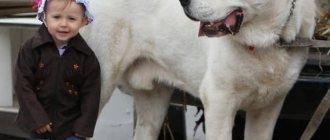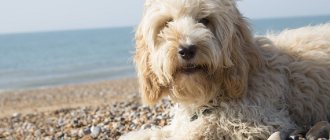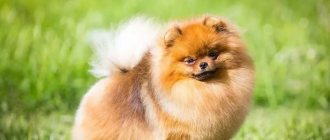The French Briard Shepherd is a great manipulator. Briard is so smart that he can easily control a person, which the owner will not even suspect. But if you raise him correctly, your pet will make an ideal obedient friend. It is for its mental abilities that the breed is valued by farmers who have large numbers of sheep. Briard manages a flock of up to 700 animals without human help. Let's find out what else these shepherds are famous for.
Description of the Briard breed
The average height of males is 65 cm, and that of females is about 60 cm. They stand out among other breeds because of their very long hair. There are several color options, we will talk about them in more detail below. The ears are not cropped, the eyes are almost covered with “eyebrows”.
Briard dog
Accepted standard • Height: male – 58.5-68.5, female – 56-65; • Weight: 25-35 kg; • Character: energetic, independent; • Wool: long, thick, goat type; • Color: any, except completely white; • Ears: covered with hair, thick; • Eyes: dark, under overhanging eyebrows; • Teeth: strong, large, white; • Withers: slightly noticeable; • Neck: muscular, small; • Back: wide; • Tail: tapering towards the tip; • Belly: tucked up; • Chest: protruding forward; • Paws: strong pads; • Movements: free and light, reminiscent of a cat.
Distinctive features
Appearance is the calling card of French Shepherds and Briards are no exception. The first thing worth noting is, of course, the thick and long hair, which often covers the dog’s eyes. In addition, the distinctive features of this breed are:
- The head is large, powerful and slightly elongated. The muzzle is distinguished by abundant hair. The nose is characterized by a black square lobe and powerful nostrils.
- The eyes are horizontally set, well opened, black and dark brown in color. Gray dogs may have gray eyes. A questioning look.
- The ears are thick, set high, covered with long hair.
- The teeth are small, snow-white, strong. The bite is correct.
- The neck is set high and muscular.
- The paws are strong and have a rounded shape (intermediate between a cat's paw and a rabbit's paw).
- The tail is long, with abundant hair, and forms a hook at the end.
- a long coat that feels like goat hair to the touch. The younger the dog, the softer the six. Briard puppies are born dark. A stable coat color in Briards appears only at 3 years of age.
Color and coat
With their luxurious coat, Briards stand out among other dogs. In some areas, the length of the fur can be 15 cm. Their body is almost evenly covered in some places with soft, in others with coarser hair. You can find dogs of various colors: • black; • gray; • red; • combination of several colors.
Black Briards
According to the breed standard, the more intense the shade, the better. One color should smoothly transition into another; white and spotted puppies are rejected by breeders and are not allowed to participate in exhibitions.
Mating
The French Briard is formed by the age of 2. Although the first heat in female dogs occurs at 8-10 months, she cannot be mated with a male dog until she is fully mature.
The first signs of pregnancy in a dog are noticeable 1.5 months after mating. It is recommended to do an ultrasound - this will rule out a false pregnancy and allow you to determine the number of babies. Usually 8-10 babies are born.
Character
In appearance, dogs seem lazy and apathetic, but in reality everything is completely different. The descendants of French Shepherds are energetic, they love movement, long walks, or better yet, jogging with their owner. If you do not pay enough attention to walking, the dog will become lethargic, angry, and its health and appearance may deteriorate. These are social dogs. They get along well with new acquaintances and get involved in games and other activities. If you walk the dog in a small group, he will constantly run from one person to another, communicating and caring, for example, checking if anyone has fallen behind the group.
They easily get used to transport and quickly adapt to changing conditions, so they are suitable companions for travelers.
An important element in raising such a dog is training. Like other shepherd dogs, Briards need an authoritative mentor as they grow up.
Application
There is no area in which the Briard Sheepdog does not shine. They are used as:
- shepherds;
- watchmen;
- security guards;
- guides;
- rescuers;
- bloodhound.
But the main calling of the French Briard is to be a companion. He is a sensitive partner, knows how to listen and adapt to the owner.
French Briards can handle any sports discipline. Agility or whitepulling, freestyle or canicross - dogs cope with everything with their inherent ease and equanimity.
Pros and cons
Let's start with the pros: • training partner. If you are a fan of jogging or long walks, the Briard will be an excellent company for you: he is always active and quite hardy; • faithful guard and protector. With proper training, it will protect your peace not only at home, but also on walks; • gets along well with children, knows how to keep a safe distance so as not to harm the baby.
Briard dogs
Interesting Facts
- A fawn Briard dog named Brutus contributed to the judicial practice of the Middle Ages, acting as a prosecutor at the trial of his master's murderer. The dog fought him, forcing him to admit his guilt. In memory of this event, a stone shield was erected in the city of Montidier.
- During the war, French Shepherd dogs took part in hostilities, carrying the wounded from the battlefield and delivering medicine and ammunition.
- The Briard breed has the same name as the material from which tobacco pipes are made. Briar material (fr. bruyère) is obtained from a tree-like growth between the root and trunk of a shrub of the heather family, sometimes called briar wood. Briard wood has nothing in common with the dog breed, except for the name.
Feeding
Comprehensive recommendations on this issue can be obtained from your veterinarian. He, having assessed the age, needs and health status of the animal, will be able to recommend the ideal food or nutrition system for this stage. When getting a dog, you need to decide on the animal’s diet. Some people prefer natural food, others industrial food. Both have their positive and negative sides.
Briard - French Shepherd
For example, when choosing a natural method, you know exactly what the dog eats, you are confident in the freshness of these products, and you know that nothing unnecessary has gotten into the food. At the same time, it is not always possible to provide the animal with all the necessary vitamins, minerals and nutrients with such a feeding system. On the other hand, industrial food already contains a full range of useful additives, but who knows what is hidden behind the pressed balls. In any case, contact your veterinarian to select the best option that suits your dog specifically.
Don't overfeed! Excess weight is not good for anyone, especially a Briard at the stage of growing up and developing joints.
Key points in training
Stubbornness and the habit of deciding everything on your own often become an obstacle to training Briards . But those who decide to get a Briard will have to be patient and persevering, because training these dogs is not as easy as it might seem at first glance.
First you need to show the dog who's boss. The main thing here is not to miss the opportunity to become a leader for your pet. Only in this case the training process will seem easy and will bring pleasure not only to the owner, but also to the pet. In this case, harsh methods of influence cannot be used. This can lead to resentment on the part of the pet.
Read about how to properly train a dog in the article: “Training a puppy: effective methods from dog handlers, learning commands at home.”
Thanks to their curiosity and ability to learn quickly, these dogs can be taught any canine sport. These dogs are especially good in such areas as pulk and ski joring.
Choosing a puppy
To ensure that your purchase does not turn into unpleasant surprises for you, contact nurseries or recommended breeders. Only knowledge of the puppy’s pedigree and the responsible attitude of professionals towards the pet during the growing period guarantees good health and socialization.
Briard puppy
If you plan to participate in exhibitions, then be guided by breed standards when choosing. Otherwise, you can choose a baby from those rejected by the breeder; they usually cost less, while differing only in appearance.
Brief history of origin
The first mentions of a breed of dogs with sheep's wool date back to the 7th-8th centuries. The exact origin of the Briard Shepherd is unknown, but it is believed that the breed arrived in France along with nomads from the East. Briard showed his excellent herding qualities, and soon every cattle owner in the province of Bri had a gorgeous curly-haired shepherd dog.
In 1863, the Briard dog breed was presented at an exhibition in Paris, and in 1885 it was included in the stud book of France. In 1897, the first standard of the Briard breed appeared in France, then the shepherd began to gain popularity in other countries. In North America, the Briard Sheepdog has been known since the 18th century, but the first litter was officially registered only in 1922.
On the territory of the former USSR, the French Briard breed appeared even later, in 1985.
Initially, the role of the curly-haired dog in human life was to guard and herd livestock. Today, the French Briard is more just a pet, as well as a guide dog for people with disabilities.
Photo
Meet the French Briard breed! In ancient times, the dog performed an excellent role as a guard and shepherd, and now it is a friendly, sociable companion. He is characterized by a caring attitude towards small animals and children, because for him they are an object that can be grazed, cared for and protected.
Interesting facts about briar
- The Briard's hanging ears add charm and uniqueness. But in the past, dogs' ears were cropped to give them an erect shape. Currently, in many European countries this procedure is prohibited. In our country, dogs' ears are cropped, but they leave a shape close to their natural appearance.
Briards do not always have a curved tail; they are born with straight tails.
Features of care
In order for your pet to look neat, it will need regular and proper grooming.
Hygiene
A set of hygiene procedures:
- Periodically (every 5-7 days) examine the ears and eyes, clean the dirt with cotton swabs or sticks with veterinary lotion or herbal decoction (calendula, chamomile, etc.). If the ears are undocked, then the hair inside the shell is cut off.
- They brush their teeth weekly with a special paste for animals that does not require rinsing, and a finger brush attachment.
- The claws are shortened with a guillotine nail clipper if they do not grind down on their own during walks.
- After each meal, the face is washed with water or wiped with wet wipes, removing any remaining food. The beard and mustache must be combed. The bangs are thinned out a little (filed) or pinned into a ponytail. For non-show animals it can be shortened.
- Trim any clumps of fur between the toes (as needed).
- The wool is carefully combed daily, first with a wide comb, removing debris and working out tangles, then with a fine-toothed comb or brush. During the procedure, conditioners are used to make combing easier.
- Water treatments are carried out 1–2 times a month, using professional cosmetics (shampoos, conditioners, balms, etc.) for long-haired animals.
The dog's long, dry hair hardly sheds, but it becomes intensely matted. So if you don’t want your pet’s body to turn into a solid, untidy “felt boot,” don’t neglect brushing it daily.
For a long-haired dog to go outside, it is better to buy protective overalls, so that later burrs and other surprises of nature are not pulled out of the fur. Our dog, for example, also loved to roll in the dust or swim in a puddle of dirty water.
Walk
Shepherd dogs require regular (2-3 times a day), long (at least an hour) walks with good physical activity. Lack of physical activity has an extremely negative impact on the character of dogs.
You need to walk a Briard a lot, and it’s better without a leash.
This breed is most suitable for people leading an active lifestyle, who can take their pet on trips out of town, cycling, hiking, morning jogging in the park, etc.
Nutrition
Very active dogs especially need a complete and balanced diet . For the “Frenchies,” special super-premium or holistic food is selected, intended for active pets (Acana Heritage Adult Large Breed, Royal Canin HE Club, etc.). Homemade, freshly prepared food will also work. Adult dogs are fed twice a day, puppies - from 3 to 6 times depending on age.
The natural diet includes:
- lean meats (horse meat, veal, turkey, etc.);
- meat trimmings and offal;
- porridge (oatmeal, buckwheat, etc.);
- seasonal fruits and vegetables, herbs;
- sea fish without bones;
- low-fat sour milk (cottage cheese, kefir, etc.);
- eggs;
- unrefined vegetable oil;
- mineral complexes and vitamin supplements.
Shepherds should not be given pasta and baked goods, canned food, potatoes, legumes, as well as fatty and sweet foods.
Health
Characteristic diseases
Almost all large breeds of dogs are more susceptible to diseases of the musculoskeletal system and joints; this feature does not bypass the Briard.
In adults, diseases such as elbow and hip dysplasia are quite common.
In addition, the animal is characterized by the following pathologies:
- Epilepsy
- Lymphosarcoma
- Bloating
- Hereditary blood disease
- Night blindness
- Retinal atrophy
- Thyroid hormone deficiency
For children, the Briard will be the best friend, showing maximum care and attention, allowing more than it should.
Vaccinations
The first general vaccination is given at the age of 9 weeks, the procedure is repeated after 3-4 weeks. Subsequently, vaccinations are given once a year.
Ten days before the actual vaccination, treatment for helminths is carried out; this measure is also mandatory.
French Shepherds do not show unreasonable aggression, they get along well in the family and get along well with other animals, if any.
